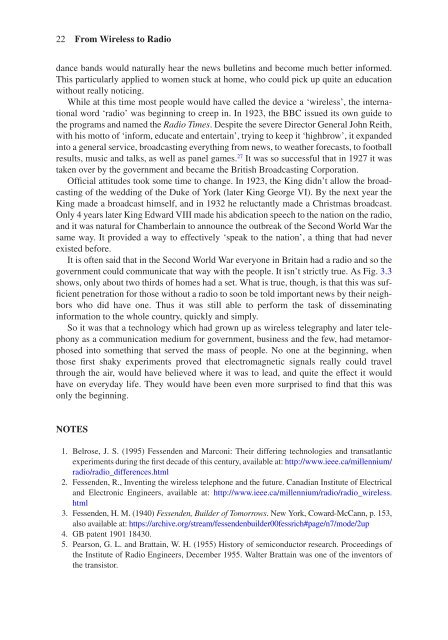The Electronics Revolution Inventing the Future
You also want an ePaper? Increase the reach of your titles
YUMPU automatically turns print PDFs into web optimized ePapers that Google loves.
22 From Wireless to Radio<br />
dance bands would naturally hear <strong>the</strong> news bulletins and become much better informed.<br />
This particularly applied to women stuck at home, who could pick up quite an education<br />
without really noticing.<br />
While at this time most people would have called <strong>the</strong> device a ‘wireless’, <strong>the</strong> international<br />
word ‘radio’ was beginning to creep in. In 1923, <strong>the</strong> BBC issued its own guide to<br />
<strong>the</strong> programs and named <strong>the</strong> Radio Times. Despite <strong>the</strong> severe Director General John Reith,<br />
with his motto of ‘inform, educate and entertain’, trying to keep it ‘highbrow’, it expanded<br />
into a general service, broadcasting everything from news, to wea<strong>the</strong>r forecasts, to football<br />
results, music and talks, as well as panel games. 27 It was so successful that in 1927 it was<br />
taken over by <strong>the</strong> government and became <strong>the</strong> British Broadcasting Corporation.<br />
Official attitudes took some time to change. In 1923, <strong>the</strong> King didn’t allow <strong>the</strong> broadcasting<br />
of <strong>the</strong> wedding of <strong>the</strong> Duke of York (later King George VI). By <strong>the</strong> next year <strong>the</strong><br />
King made a broadcast himself, and in 1932 he reluctantly made a Christmas broadcast.<br />
Only 4 years later King Edward VIII made his abdication speech to <strong>the</strong> nation on <strong>the</strong> radio,<br />
and it was natural for Chamberlain to announce <strong>the</strong> outbreak of <strong>the</strong> Second World War <strong>the</strong><br />
same way. It provided a way to effectively ‘speak to <strong>the</strong> nation’, a thing that had never<br />
existed before.<br />
It is often said that in <strong>the</strong> Second World War everyone in Britain had a radio and so <strong>the</strong><br />
government could communicate that way with <strong>the</strong> people. It isn’t strictly true. As Fig. 3.3<br />
shows, only about two thirds of homes had a set. What is true, though, is that this was sufficient<br />
penetration for those without a radio to soon be told important news by <strong>the</strong>ir neighbors<br />
who did have one. Thus it was still able to perform <strong>the</strong> task of disseminating<br />
information to <strong>the</strong> whole country, quickly and simply.<br />
So it was that a technology which had grown up as wireless telegraphy and later telephony<br />
as a communication medium for government, business and <strong>the</strong> few, had metamorphosed<br />
into something that served <strong>the</strong> mass of people. No one at <strong>the</strong> beginning, when<br />
those first shaky experiments proved that electromagnetic signals really could travel<br />
through <strong>the</strong> air, would have believed where it was to lead, and quite <strong>the</strong> effect it would<br />
have on everyday life. <strong>The</strong>y would have been even more surprised to find that this was<br />
only <strong>the</strong> beginning.<br />
NOTES<br />
1. Belrose, J. S. (1995) Fessenden and Marconi: <strong>The</strong>ir differing technologies and transatlantic<br />
experiments during <strong>the</strong> first decade of this century, available at: http://www.ieee.ca/millennium/<br />
radio/radio_differences.html<br />
2. Fessenden, R., <strong>Inventing</strong> <strong>the</strong> wireless telephone and <strong>the</strong> future. Canadian Institute of Electrical<br />
and Electronic Engineers, available at: http://www.ieee.ca/millennium/radio/radio_wireless.<br />
html<br />
3. Fessenden, H. M. (1940) Fessenden, Builder of Tomorrows. New York, Coward- McCann, p. 153,<br />
also available at: https://archive.org/stream/fessendenbuilder00fessrich#page/n7/mode/2up<br />
4. GB patent 1901 18430.<br />
5. Pearson, G. L. and Brattain, W. H. (1955) History of semiconductor research. Proceedings of<br />
<strong>the</strong> Institute of Radio Engineers, December 1955. Walter Brattain was one of <strong>the</strong> inventors of<br />
<strong>the</strong> transistor.


















